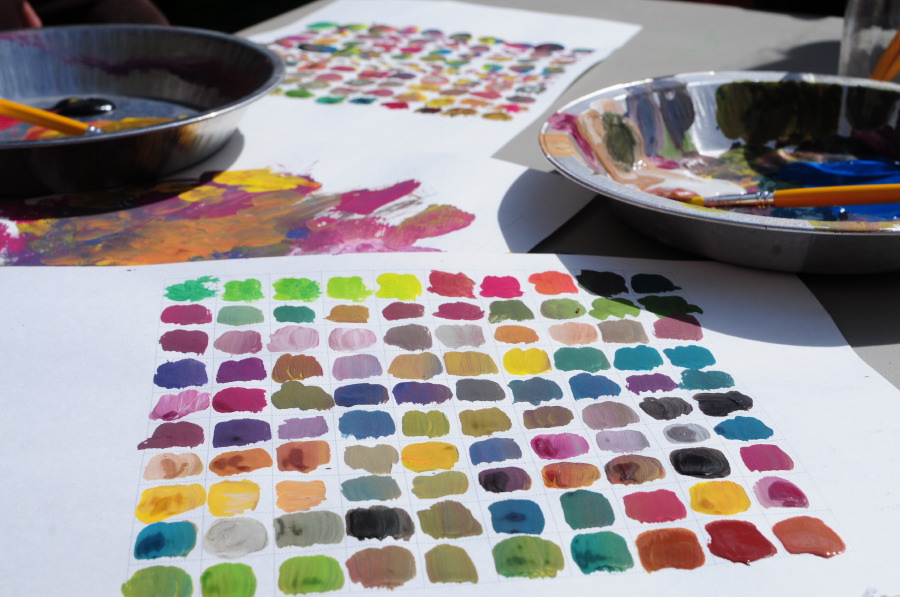Acid Dye is a fancy name for food coloring. Okay, okay, food colors belong to the class of dyes known as acid dyes. Are food colors acids? No, acid dyes are called acid dyes because the chemical reaction between the fiber and dye requires acid. Now you know!
Two of the best things about dyeing with food coloring are that you can get very brilliant colors, and it is quite safe to do with kids. One of the downsides is that it really only works on protein fibers like wool and silk. (More on that in Part 2.) But it doesn’t have to be 100% wool or silk, you can use blends as long as you are happy with less saturated colors. I have a bamboo/silk (70%/30%) blend that I’ve used that comes out very nicely and has a lovely shiny texture.
What do you need to dye yarn with food colors? Food colors, vinegar, wool, containers, and some heat. And please don’t use the same containers for art and food, I know it’s food safe dye, but you don’t know what your wool has been processed with.
Step 0: Tie your yarn into mini skeins – basically wrap all of it around your hand and then tie some waste yarn around the loops to hold them together. This is just to keep them from turning into a giant knotted mess. Traditional skeins are tied in three places, if you are dyeing larger amounts of yarn this is important, tiny bundles need less marshaling, and I am lazy. I usually only use one tie, I pick the yarn up by the tie, give it a shake, and it generally comes out fine.
Step 1: Soak
Presoak your yarn in vinegar. You can dilute your soaking solution to 2 parts to 1 part vinegar, although I have found that you need either straight vinegar or multiple soak-dye cycles to get good reds.
VARIATION 1 – single color
Step 2: Dye
Squeeze your yarn out and put it in a glass jar or other microwave safe container with enough water to cover it. Drip food colors in drop by drop to mix colors.
Step 3: Heat
Cover your jars and microwave until the water turns clear. You may have to look into the top of the jar to see the clearness of the water, looking in from the side the colored yarn tends to make the water look colored also.
Step 4: Rinse
Rinse and dry!
VARIATION 2 – rainbow yarn
Step 2: Dye
Squeeze your yarn out and put it on a microwave safe plate (paper works fine, and if they are sturdy you can rinse and reuse them many times). Squirt diluted food colors or drip straight food colors onto your yarn. If you don’t have tiny squeeze bottles you can also dilute your food coloring and spoon it onto the yarn. In general I mix one ounce of water to 8 drops of food coloring, double for red.
Step 3: Heat
Put a matching plate over the top of the yarn to keep it from splattering all over your microwave. (Ah yes, experience. At least it seems to wipe up easily and doesn’t stain the enamel.) Heat your yarn until you hear it softly popping. Steaming hot, about 30s for the small bundles of yarn we use. Leave the plate on top and let it rest for another minute. This is not strictly necessary if you are 3 and super anxious, but less of your color will set.
Step 4: Rinse.
Rinse and squeeze dry. Done!
Now we have lots of yarn in lots of colors and combinations. And it really is simple, Rebecca ran this mostly on her own, as a craft activity to earn money at our school’s December craft fair.
One of my favorite things to do with the rainbow yarn is to make half hitch bracelets. The kind where you have one core strand of yarn, and you tie half hitch after half hitch around it with your rainbow yarn, making a spiral rainbow bracelet.
Next up, Part 2, a fiber science demonstration, then Part 3, an art activity. 🙂












5 Comments
Add Yours →Emma would love to make a bracelet like that – I remember making those as a kid. Thanks for the idea!
Your colors came out great! My kids loved dying yarn with kool-aid last summer, and we need to do it again.
[…] you missed Acid Dye Part 1, it contains the basic instructions for acid dyeing. Basic overview: Food colors are acid dyes, you […]
I need to keep your instructions somewhere. From what age do you think that is interesting? And how do you the bracelet?
Maybe you could make pinterest boards for different ages? Or just assume that everything will come around again, there are always so many fascinating things to do that maybe you don’t need to remember what we wrote about last year, if it was really worth it someone will write about it again?
Do you know how to tie a half hitch? You just take two cords, one short and one quite long, and tie the long one around the short one lots of times using a half hitch knot. Here is a better explanation: http://www.free-macrame-patterns.com/half-hitch-spiral.html
[…] you missed it Acid Dye Part 1 describes the basic dyeing process, and Acid Dye Part 2: Science is a fun dye science […]